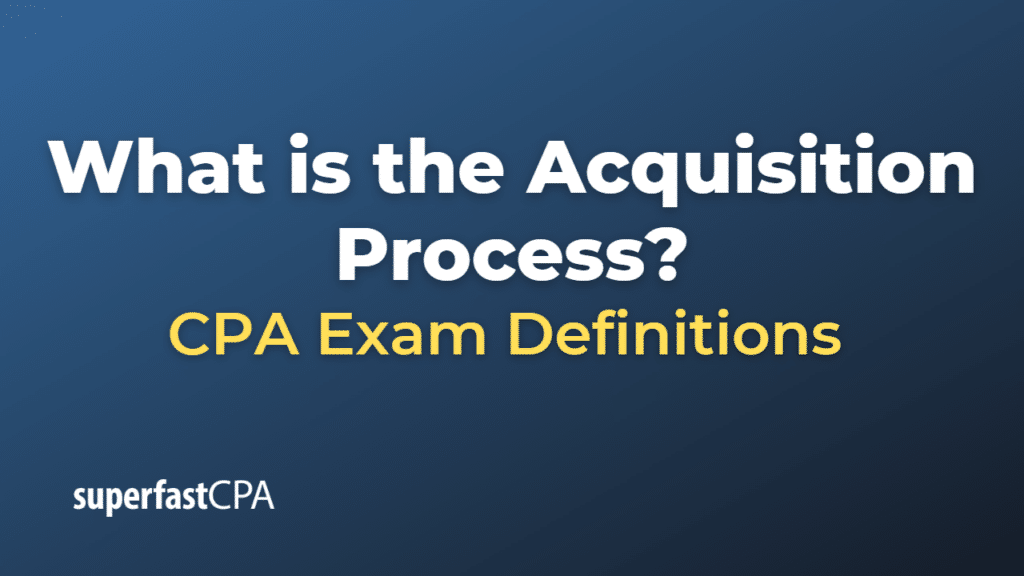Acquisition Process
The acquisition process is a series of steps that a company goes through when it wants to acquire another company. The process can vary depending on the size and complexity of the companies involved, as well as the nature of the deal. Here is a general outline of the acquisition process:
- Strategy development: The acquiring company identifies its strategic objectives and determines how an acquisition can help achieve those goals. This may involve analyzing the market, assessing competitors, and identifying potential target companies.
- Target identification: The acquiring company creates a list of potential target companies that align with its strategic objectives. This can involve conducting research, analyzing financial data, and assessing the compatibility of the target company’s operations, products, or services.
- Preliminary assessment: The acquiring company evaluates the potential target companies based on various criteria, such as financial performance, market position, and growth potential. This stage may also involve initial contact with the target company to gauge interest in a potential acquisition.
- Valuation: The acquiring company estimates the value of the target company, taking into account factors such as assets, liabilities, future cash flows, and growth potential. This valuation helps determine the purchase price for the target company.
- Negotiation: The acquiring company and the target company negotiate the terms of the acquisition, including the purchase price, payment method (cash, stock, or a combination), and any conditions that must be met before the deal can close.
- Due diligence: The acquiring company conducts a thorough investigation of the target company to verify its financial statements, assess its operations, and identify any potential risks or liabilities. This stage may involve reviewing contracts, customer relationships, intellectual property, and employee matters.
- Finalizing the deal: If due diligence is satisfactory, the acquiring company and the target company sign a definitive agreement outlining the terms of the acquisition. This agreement is then submitted for regulatory and shareholder approvals.
- Integration: After the acquisition is completed, the acquiring company integrates the target company into its operations. This can involve consolidating departments, integrating systems and processes, and aligning company cultures.
- Performance monitoring: The acquiring company monitors the performance of the acquired business to ensure that it is meeting strategic objectives and contributing to the overall success of the company. This may involve tracking financial performance, customer satisfaction, and other key performance indicators.
Throughout the acquisition process, communication with stakeholders, including employees, customers, suppliers, and investors, is crucial to ensure a smooth transition and the success of the acquisition.
Example of Acquisition Process
Let’s consider a hypothetical example of an acquisition process:
Company A is a leading software company that specializes in providing cybersecurity solutions. The management of Company A decides that they want to expand their product offerings and enter the growing market of data privacy software. To achieve this goal quickly, they decide to acquire a company that already has a strong presence in the data privacy market.
- Strategy development: Company A identifies its strategic objectives, which include expanding its product offerings, increasing market share, and generating new revenue streams.
- Target identification: Company A conducts market research and identifies several potential target companies that specialize in data privacy software.
- Preliminary assessment: Company A evaluates the financial performance, market position, and growth potential of the potential target companies and narrows down the list to three candidates. They initiate contact with these companies to gauge their interest in a potential acquisition.
- Valuation: Company A conducts a valuation of the three target companies and estimates their worth based on factors such as assets, liabilities, future cash flows, and growth potential.
- Negotiation: Company A selects Company B, a leading data privacy software provider, as their preferred target and enters into negotiations. After several rounds of discussions, both parties agree on a purchase price and other terms of the acquisition.
- Due diligence: Company A conducts due diligence on Company B, verifying its financial statements, assessing its operations, and identifying any potential risks or liabilities.
- Finalizing the deal: Satisfied with the results of the due diligence, Company A and Company B sign a definitive agreement outlining the terms of the acquisition. They submit the agreement for regulatory and shareholder approvals.
- Integration: Upon obtaining the necessary approvals, Company A begins integrating Company B into its operations. This involves consolidating departments, integrating systems and processes, and aligning company cultures.
- Performance monitoring: Company A continuously monitors the performance of the acquired business (Company B) to ensure that it is meeting strategic objectives and contributing to the overall success of Company A.
In this example, Company A successfully acquires Company B to expand its product offerings, enter a new market, and increase its overall market share.













